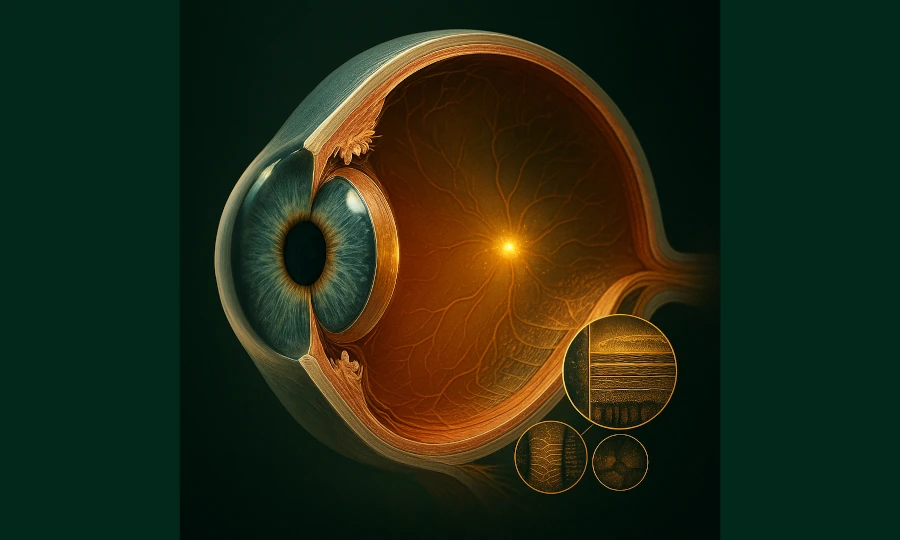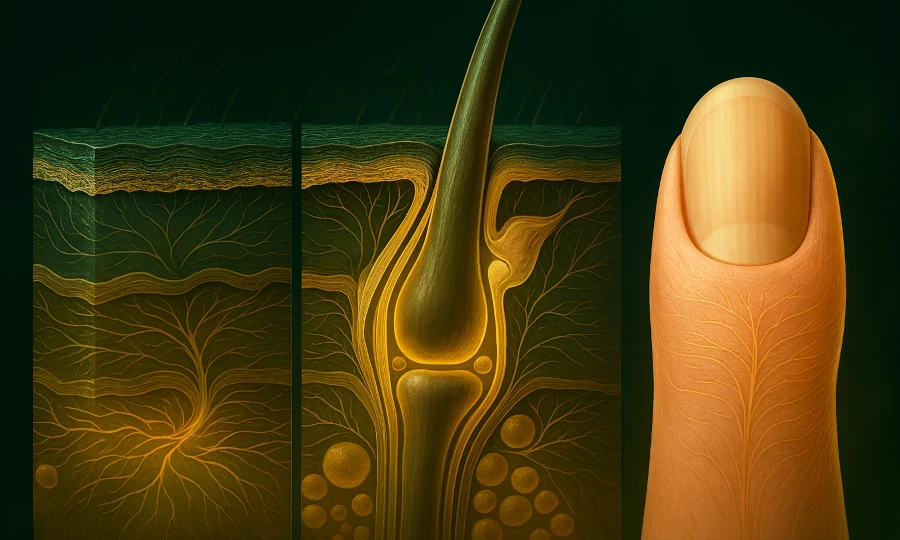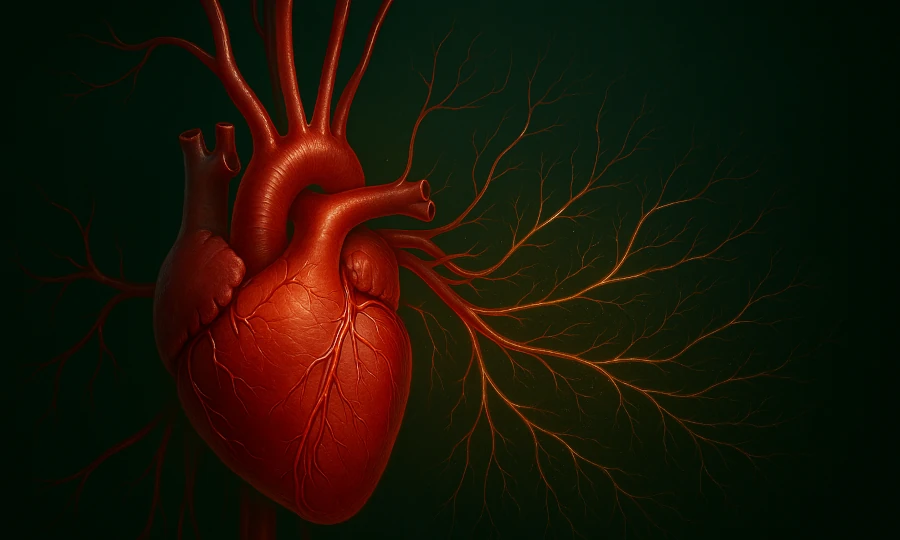
Vision is one of our most precious senses – allowing us to perceive the beauty of the world around us, gather information, and maintain connection with our surroundings. However, eyes are also extremely delicate and complex organs that face daily challenges from blue light from digital devices, UV radiation, environmental pollutants, and oxidative stress.
Comprehensive Support for Eye and Vision Health
Roanga Infinity® contains powerful natural antioxidants and plant extracts that can contribute to protecting eye cells from oxidative stress and supporting healthy vision function. The synergy of these substances provides natural support for maintaining clear and vital vision.
Modern scientific research suggests that optimal eye and vision health depends on the interplay of several key factors:
- Protection from oxidative stress and free radical damage
- Optimal microcirculation and nutrient supply to eye structures
- Healthy function of the nervous system and visual pathways
- Structural integrity of eye tissues
Antioxidant Protection for Vision
Eyes are exposed to significant oxidative stress that can damage delicate structures of the retina, lens, and other eye tissues. The retina is particularly sensitive to oxidative damage due to its high metabolic activity and the presence of light-sensitive photoreceptors.
OPC (oligomeric proanthocyanidins) from grape seeds, lycopene from tomatoes, and fucoidan from seaweed can help neutralize free radicals and protect delicate eye structures from oxidative damage. A systematic review published in the journal Nutrients (2019) documents that these natural antioxidants can contribute to protecting eye tissues from oxidative stress (Li et al., 2019).
These natural antioxidants can help:
- Neutralize free radicals in eye tissues
- Support natural antioxidant systems in the eye
- Protect light-sensitive cells of the retina from damage
- Contribute to maintaining the transparency of the eye lens
Supporting Microcirculation
Optimal blood circulation is essential for supplying eye structures with oxygen and nutrients. The retina has one of the highest metabolic activities in the body and requires a constant supply of nutrients to maintain its functions. With age, changes in microcirculation can occur that may affect the health and function of eye tissues.
Ginseng (Panax ginseng) and grape extracts can contribute to normal blood circulation, which is important for supplying the retina and optic nerve with nutrients. A study published in the Journal of Ginseng Research (2020) suggests that bioactive components of ginseng can support microcirculation and contribute to protecting nerve tissues (Park et al., 2020).
These natural substances can help:
- Support healthy blood circulation in small vessels of the eye
- Contribute to optimal supply of eye tissues with oxygen and nutrients
- Support healthy function of the endothelium (inner lining of blood vessels)
- Contribute to normal blood viscosity and flow through capillaries
"Eye health and vision clarity are the result of a delicate balance between protection, nutrition, and regeneration of eye tissues. Natural substances can contribute to maintaining this balance and support vision vitality at any age."
Nervous System Balance
Vision is a complex process involving not only the eyes but also the visual pathways and the brain's visual center. Healthy function of the nervous system is therefore key for optimal processing of visual perceptions and clarity of vision.
Reishi (Ganoderma lucidum) and aloe vera can support harmony of the neuro-immune system, which can benefit healthy vision function. Scientific studies suggest that bioactive polysaccharides from reishi may have neuroprotective effects and support health of nerve cells (Weng et al., 2018, International Journal of Molecular Sciences).
These natural substances can help:
- Support healthy function of nerve cells involved in the vision process
- Contribute to normal adaptation to changes in light intensity
- Support natural regeneration of nerve tissues
- Contribute to overall neuro-immune balance
Overall Cell Vitality
Structural integrity of eye tissues is an important aspect of vision health. The eye contains various types of connective tissues that provide support and maintain proper function of the optical system. With age, changes can occur in these structures, which may affect vision quality.
Collagen and bioactive peptides from deer velvet provide building components important for tissue health, including connective structures of the eye. A study published in the Journal of Medicinal Food (2018) suggests that bioactive peptides can support cellular vitality and contribute to structural integrity of tissues (Yao et al., 2018).
These natural structural components can help:
- Provide building blocks for renewal of eye tissues
- Support health of connective structures of the eye
- Contribute to optimal hydration of eye tissues
- Support overall cell vitality in eye structures
Holistic Approach to Eye and Vision Health
Eye health and vision clarity are the result of a complex interplay of many bodily systems and processes. Modern scientific findings confirm that optimal support requires a holistic approach that focuses on key aspects of vision health – from protection against oxidative stress through support of microcirculation to nutrition and regeneration of eye tissues.
Roanga Infinity® offers comprehensive natural support that combines traditional wisdom with modern scientific knowledge. Carefully selected natural substances work in synergy and can contribute to natural protection and clarity of vision, which are the foundation of healthy and vital eyesight.
Note: Roanga Planet products are dietary supplements that can contribute to supporting natural processes in the body. They are not intended to diagnose, treat, cure, or prevent any disease.
Frequently Asked Questions about Eye and Vision Health
How does eye and vision health change with age?
With advancing age, natural changes occur in eye structures and functions. After the age of 40, the ability of the lens to accommodate (focus on near objects) gradually decreases, leading to presbyopia or "age-related farsightedness." The eye lens may lose transparency and elasticity, which can lead to cataract development. Tear production may decrease, which can cause dry eyes. Changes in photoreceptor density and alterations in the pigment epithelium may occur in the retina, which can affect vision quality. Microcirculation in eye tissues may also change, which can affect nutrient supply to the retina. The good news is that with proper care, protection from UV radiation, appropriate nutrition, and dietary supplements, these natural processes can be optimally supported and contribute to maintaining eye health and vision even at an older age.
What is the importance of antioxidants for eye health?
Antioxidants play a key role in protecting eye tissues from oxidative stress, which is one of the main factors contributing to age-related changes. Eyes are particularly susceptible to oxidative damage for several reasons: they are constantly exposed to light, which can generate reactive oxygen species; the retina has high metabolic activity, leading to free radical production; and photoreceptor membranes contain high concentrations of polyunsaturated fatty acids, which are susceptible to oxidation. Natural antioxidants such as OPC from grapes, lycopene from tomatoes, lutein, zeaxanthin, or vitamins C and E can neutralize free radicals and protect eye structures from damage. Studies such as AREDS (Age-Related Eye Disease Study) have shown that certain combinations of antioxidants can support eye health and contribute to maintaining visual functions.
Why is microcirculation important for eye health?
Microcirculation plays an essential role in supplying eye tissues with oxygen and nutrients. The retina is one of the most metabolically active tissues in the body and consumes large amounts of oxygen and glucose for its function. Insufficient blood flow through tiny retinal vessels can lead to inadequate supply of photoreceptors and other cells, which can negatively affect their function and vitality. Optimal microcirculation also ensures efficient removal of metabolic waste products. With age, changes can occur in the eye's vascular system, including loss of vessel elasticity, reduction in their diameter, and changes in vascular wall permeability. Natural substances that support healthy blood circulation, such as flavonoids from grapes or ginsenosides from ginseng, can contribute to optimal microcirculation in eye tissues and thus support their healthy function.
How is the nervous system related to vision health?
Vision is a complex sense that involves much more than just the eyes. Light captured by photoreceptors in the retina is converted into electrical signals that are transmitted through the optic nerve to the brain, where they are processed and interpreted as visual perceptions. This process requires proper function of nerve cells, synaptic connections, and brain centers. The health of the nervous system is therefore crucial for optimal processing of visual information and vision quality. Neuroprotective substances, such as polysaccharides from reishi or ginsenosides from ginseng, can support health of nerve cells and contribute to protecting visual pathways from damage. Substances with antioxidant properties can also protect nerve cells from oxidative stress, which can negatively affect their function and vitality.
What is the relationship between digital devices and eye health?
Modern lifestyle with intensive use of digital devices presents a new challenge for eyes. Long-term screen viewing can lead to digital eye syndrome, which includes symptoms such as eye fatigue, blurred vision, dryness and eye irritation, or headaches. Several factors contribute to this strain: reduced blinking frequency when viewing screens leads to drying of the eye surface; blue light emitted by screens can increase oxidative stress in the retina; and constant focusing at the same distance strains eye muscles. Natural substances with antioxidant properties, such as OPC from grapes or lycopene, can help neutralize free radicals generated during exposure to blue light. Substances supporting tear production and hydration of the eye surface can also contribute to eye comfort when working with digital devices. However, in addition to dietary supplements, it is important to follow the 20-20-20 rule (every 20 minutes, look at an object at least 20 feet away for 20 seconds) and ensure proper lighting and ergonomics of the work environment.
Sources and References
- Zhiyan Jia, Zhen Song, Yuhui Zhao, et al. (2011). Grape seed proanthocyanidin extract protects human lens epithelial cells from oxidative stress via reducing NF-кB and MAPK protein expression. (pmc.ncbi.nlm.nih.gov/articles/PMC3025097/)
- Suresh Kumar Gupta PhD, Deepa Trivedi PhD, Sushma Srivastava PhD, et al. (2018). Lycopene attenuates oxidative stress induced experimental cataract development: an in vitro and in vivo study. (www.sciencedirect.com/science/article/abs/pii/S0899900703001400)
- Philipp Dörschmann, Alexa Klettner, et al. (2020). Fucoidans as Potential Therapeutics for Age-Related Macular Degeneration—Current Evidence from In Vitro Research. (www.mdpi.com/1422-0067/21/23/9272)
- Park, H.J., et al. (2020). Neuroprotective effects of Panax ginseng extract against ischemic damage via regulation of the inflammatory response and apoptosis. Journal of Ginseng Research, 44(2), 267-274. (doi.org/10.1016/j.jgr.2018.12.011)
- Weng, Y., et al. (2018). Ganoderma lucidum polysaccharides protect against MPP+ and MPTP-induced neurotoxicity in primary mesencephalic cells and mice. International Journal of Molecular Sciences, 19(6), 1689. (doi.org/10.3390/ijms19061689)


